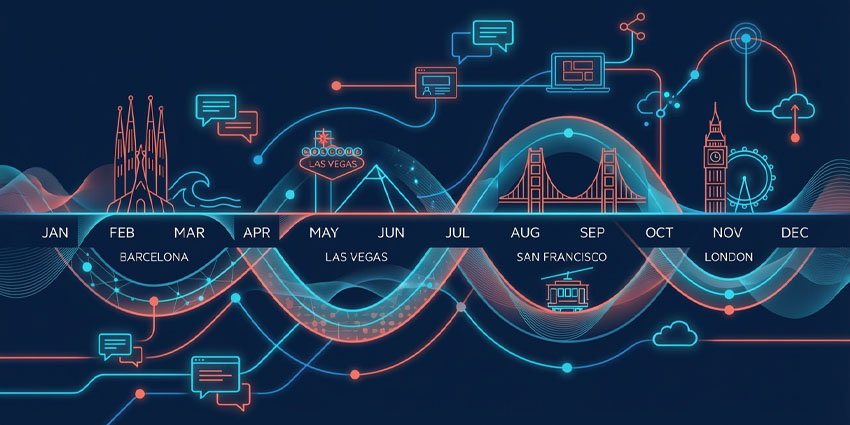In the last few years, video conferencing solutions have evolved from a “nice to have” concept in business environments, to essential tools for productivity and collaboration. As of 2023, around 37.82% of US employees are using video conferencing tools at least once or twice a week.
As demand for flexible opportunities like hybrid and remote work continues to grow, the need for effective video conferencing tools will only expand. Studies show that the market for video conferencing will reach a massive $19.1 billion by 2027, with a CAGR of 12.6%.
In this evolving world, a few key trends have emerged, highlighting the changing direction of the video conferencing space. Here are the trends your business should be watching as we head into 2024.
1. Flexibility: Freedom to Use Any Device
Since the pandemic, employees have become more accustomed to using their own tools for communication. When working from home, employees don’t have access to the same cameras, microphones, and hardware they would have in the office.
Training team members to utilise new tools is a time-consuming and frustrating process for most businesses, leading to the rise of Bring Your Own Device (BYOD) strategies. However, allowing users to bring their own devices into the meeting room can come with its own challenges. Companies now need meeting software and hardware to accommodate a wide range of tools and accessories.
Software solutions like Microsoft Teams need to be able to accommodate all kinds of camera equipment and meeting room solutions. Similarly, the hardware at the foundation of meeting kits needs to be able to adapt to the unique needs of each company.
For instance, companies creating dynamic hybrid meeting rooms need multi-media solutions that can connect with virtually any camera or audio kit. More flexible solutions ensure teams can stay productive anywhere, and launch meetings, and discussions in seconds.
2. Simplicity for Use and Configuration
In the past, the widespread adoption of video conferencing was often hampered by complexity. Setting up meeting rooms and configuring them for users took significant time and effort. Additionally, many employees needed to be trained on how to use tools for recording, streaming, file sharing, and countless other features.
As video interactions become a more commonplace part of working life, today’s companies don’t have the time for complex systems. They need plug-and-play solutions which allow them to turn any room into a collaborative environment in seconds. The simpler the solution is to use, the less time employees waste before and after collaborative conversations.
It’s not just ease of use for everyday employees that’s important in today’s world either. Companies need to ensure they can monitor, manage, and control meeting solutions from a distance. This has led to the rise in web-based interfaces, where companies can access solutions remotely, create personalised profiles to suit their specific use cases, and more.
3. Inclusivity and Engagement
As of 2022, only around 32% of full-time and part-time employees felt engaged in the workplace. This diminishing engagement is just exacerbated by the fact that many team members are now operating in siloed environments, reducing the opportunity for interaction and bonding.
Since flexible work isn’t going anywhere, companies need a way to ensure they can make all employees feel engaged and included in the workplace, regardless of where they are. Fortunately, video conferencing vendors and innovators are taking note of this demand.
Increasingly, companies are introducing new, more intelligent technologies, designed to bridge the gaps between staff members. High-definition AV technologies are becoming more common, allowing employees to feel as though they’re in the same room as the people they’re speaking to.
Additionally, video vendors are beginning to offer more advanced meeting kits for remote workers, ensuring they can access the same quality connection when they’re working from home.
4. Advanced Features for Different Use Cases
During the early stages of the pandemic, when the adoption of video conferencing technologies accelerated, the focus for everyone was on simplicity. Video still wasn’t ubiquitous in the office, and companies needed to overcome employee resistance. Now, we’re all a lot more aware of the value video can bring to our interactions.
As a result, companies are also ready to embrace more advanced features in their video technologies, which allow them to embed their solutions into different use cases. Specialist solutions are beginning to emerge for different industries, such as visualisers (document cameras) for students and teachers in the education sector, and real-time monitoring tools for the healthcare sector.
Video cameras can also do a lot more, from creating picture-in-picture displays for demonstrations, to leveraging internal tools to eliminate visual noise. As these tools become more advanced, they’re paving the way to the broader use of video in all parts of the business environment.
5. AI and Automation
Finally, AI and automation has had a resounding impact on virtually every aspect of the business environment, including the video conferencing space. Video conferencing software providers, like Teams and Webex, are embedding AI tools into their solutions that can take notes in real-time, summarise meetings, or even translate conversations.
At the same time, AI and automation tools are beginning to appear in video conferencing software. Advanced tools can now use artificial intelligence to automatically track human voices, ensuring a speaker always gets their audience’s full attention. They can include dynamic detection tools for pinpointing and framing participants in a meeting session.
Some solutions even come with gesture control, to minimise the need to interact with a device during a presentation or discussion. These AI solutions are making video experiences more sleek, intuitive, and reliable for businesses of all sizes.
The Rapid Evolution of Video Conferencing Technology
Rene Nuhay, SVP of Sales and Marketing at AVer Europe says “Video conferencing is about the seamless connection of ideas and collaboration. AVer Europe is at the forefront, shaping a future where virtual meetings transcend expectations.
With each camera, videobar and a professional audio partner, you can see the precision and clarity that defines AVer’s dedication to transformative communication.”
Video conferencing technologies and tools have become a mainstream part of the communication stack in the last couple of years. Virtually every company now relies on video solutions for meetings, collaboration, employee engagement, and even events.
As the workplace and business environments continue to evolve, the trends in the video conferencing space will transform with them. In the years ahead, we can expect to see not just wider adoption of advanced technology, but more powerful features, flexibility, and greater ease of use for everyone.







